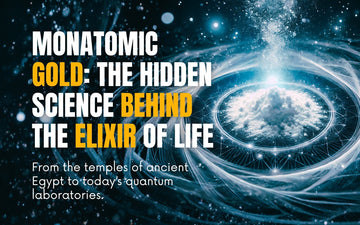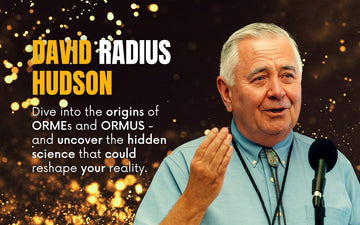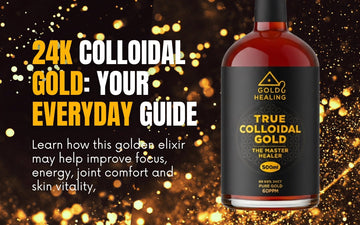Monatomic Gold: The Hidden Science Behind the Elixir of Life
From the temples of ancient Egypt to today’s quantum laboratories, gold has always symbolised purity, power, and illumination. Once reserved for kings and gods, this radiant metal is now at the centre of a modern mystery — monatomic gold (also called ORME or Ormus). Advocates describe it as a bridge between matter and spirit, while emerging research hints at surprising biological and electromagnetic properties.

In this article, we explore the history, science, and consciousness potential of monatomic gold — blending ancient wisdom with cutting-edge studies in nanotechnology, superconductivity, and quantum biology.
1. Gold as a Healer Through the Ages
Throughout history, gold has been revered as both a divine metal and a healing element. Ancient Egyptian texts described a mysterious white powder called mfkzt — believed by some researchers to be a form of purified gold used in the temples of Ra and Osiris (Frontiers in Chemistry, 2023). In China’s Tang dynasty, alchemists mixed gold into elixirs meant to “stabilise the spirit and lengthen life,” while Ayurvedic medicine in India used Swarn Bhasma (calcined gold ash) for immunity, vitality, and mental clarity.

Even Cleopatra reportedly applied a 24-karat gold mask nightly to preserve her youth and luminosity. Across cultures, gold was seen not merely as a mineral, but as a conductor of life energy — the physical reflection of the sun’s eternal light.
2. The Rediscovery: David Hudson and ORME
The modern story of monatomic gold begins in the late 1970s with Arizona farmer David Hudson. While analysing soil residues rich in platinum-group metals, Hudson found a white, non-metallic powder that defied conventional chemical classification. After years of spectroscopy and magnetic testing, he coined the term ORME — Orbitally Rearranged Monoatomic Elements — describing a unique state where normally metallic atoms exist separately, not bound in lattices (Open College, 2024).

Hudson proposed that in this form, gold and similar elements (rhodium, iridium, palladium) exhibited superconductive properties at room temperature — capable of carrying current without resistance. He linked these phenomena to ancient alchemical references such as the Egyptian mfkzt and the Hebrew “Shem-an-na” — the “white powder of projection.” While mainstream physics did not confirm all his findings, Hudson’s work inspired decades of independent research into the interface between quantum materials and biology.
3. The Quantum and Biological Nature of Gold
Gold is far more than ornamental metal. In its nanoparticle or ionised form, it demonstrates unusual interactions with biological systems. Modern nanoscience has revealed that gold nanoparticles can cross the blood-brain barrier and localise in neural tissue, potentially enabling targeted therapies for neurological diseases (PubMed, 2022).

At the cellular level, gold exhibits bioelectrical resonance — it can stabilise voltage potentials and influence redox signalling (Nature Nanotechnology, 2022). Some researchers propose that this conductive property may underlie reported effects such as improved cognition, mood stability, and faster tissue regeneration. Although these outcomes are preliminary, they resonate intriguingly with traditional claims that gold “harmonises the nervous system” and “amplifies life force.”
4. ORMUS and Superconductivity
In the ORMUS: The Elixir of the Sea and the Shadow of the Cosmos (2025) manuscript, researcher Daniel Reyes Sánchez describes monatomic gold as a room-temperature quantum superconductor. He argues that when metallic clusters break into individual atoms, their spin alignment allows zero electrical resistance and the spontaneous formation of magnetic vortices — similar to Meissner-effect behaviour seen in laboratory superconductors.

According to Reyes Sánchez, these properties could interact with biological fields, enhancing coherence between cells through photon emission and resonance. He correlates this with biophoton theory — the idea that living cells emit ultra-weak light guiding communication and repair (Frontiers in Neuroscience, 2023). ORMUS, he suggests, may stabilise these light channels, supporting clarity of thought and emotional equilibrium.
5. The Spiritual and Energetic Dimension
Beyond chemistry, monatomic gold occupies a symbolic and metaphysical space. Many practitioners associate it with the activation of the pineal gland — often called the “seat of the soul.” The pineal’s crystalline micro-structures respond to electromagnetic fields and may produce endogenous DMT under certain conditions (PubMed, 2021).

In Hermetic and Kabbalistic traditions, gold represented solar consciousness — the unification of matter and spirit. ORMUS proponents claim that this subtle form of gold resonates with the body’s biofield, balancing chakras and strengthening the auric field. While empirical evidence is limited, neuroimaging research does confirm that meditative states and coherent brain rhythms correlate with higher electromagnetic synchrony between hemispheres (Frontiers in Psychology, 2021).
6. Modern Research and Emerging Evidence
Contemporary science is beginning to validate some of the peripheral ideas that early ORMUS advocates proposed — though within strictly physical frameworks. Studies on gold nanoparticles demonstrate antioxidant, anti-inflammatory, and neuroprotective actions, especially in models of Alzheimer’s and Parkinson’s disease (Frontiers in Chemistry, 2022). Other experiments show gold’s ability to catalyse DNA repair enzymes and stabilise mitochondrial membranes (ScienceDirect, 2023).

Parallel research in quantum biology reveals that living organisms use quantum tunnelling and spin coherence in photosynthesis and magnetoreception. If similar coherence occurs in the nervous system, materials that enhance quantum alignment — like ORMUS-type gold — might theoretically boost subtle energy processing. These ideas remain speculative but open intriguing paths for interdisciplinary study.
7. Safety and Scientific Caution
While colloidal and ionic gold preparations have been shown to be generally well tolerated at micro-doses, the specific chemistry of “monatomic” gold has not been fully characterised. Traditional Swarn Bhasma and pharmaceutical gold compounds (such as Auranofin) are well-studied, but ORME products vary widely in composition. Researchers caution that unknown extraction methods or impurities could affect safety profiles (Frontiers in Pharmacology, 2022).

Therefore, monatomic gold should be approached as a supplement to spiritual or wellness practice — not a replacement for medical treatment. Always consult a qualified practitioner before combining ORMUS with medications or other active supplements.
8. Key Takeaways
- Gold has been revered for healing and consciousness elevation since antiquity.
- David Hudson’s discovery of ORME proposed a mono-atomic, superconductive state of gold.
- Modern studies confirm gold’s bioelectrical and neuroprotective properties at the nanoscale.
- Monatomic gold remains scientifically debated, but its metaphoric and energetic significance endures.
- Exploring ORMUS invites a holistic view of healing — chemistry, energy, and consciousness intertwined.
9. Closing Reflections
Whether viewed through the lens of ancient alchemy or quantum physics, monatomic gold embodies humanity’s enduring quest to understand transformation. The same metal that powers electronics and symbolises wealth might also illuminate deeper layers of consciousness and coherence within the body. As research evolves, the mystery of gold — physical and spiritual — continues to unfold.
To explore our own small-batch preparation inspired by both tradition and modern purity standards, visit our Ormus Monatomic Gold Liquid page.
Disclaimer: This content is for educational purposes only and does not constitute medical advice. Always consult a qualified professional before starting any supplement regimen.





